#cultural appropriation
Explore tagged Tumblr posts
Text
Baldur's Gate 3 Appropriates Sacred Indigenous Tattoos
I was so disappointed to boot up the character creation for Baldur's Gate 3's full release, only to see they added tattoo designs that are very clearly copying from sacred tattooing practices of the Inuit and the Māori.
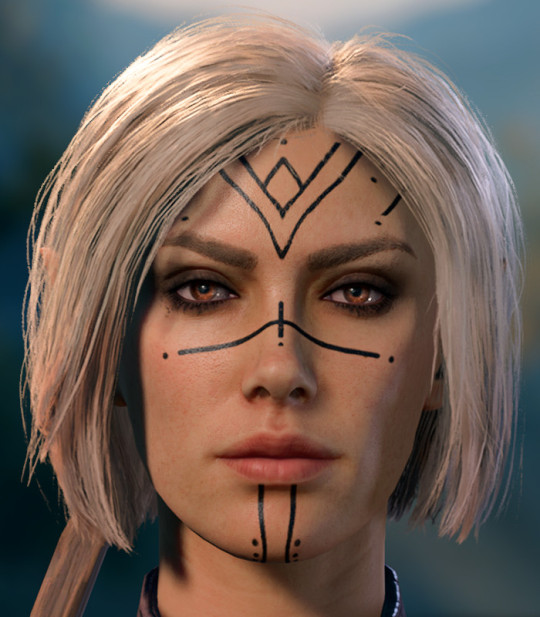
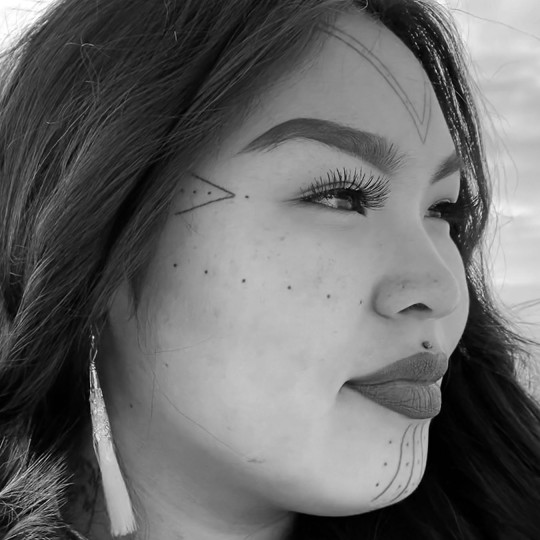
^ This is clearly copying Tunniit.




^ This is clearly copying Tā moko.
Please do not use these tattoos. Larian should never have included these designs. I personally plan on modding them out of the game at the first opportunity.
11K notes
·
View notes
Text
YOUR FAVE IS ANTI NATIVE: Temu and Shein
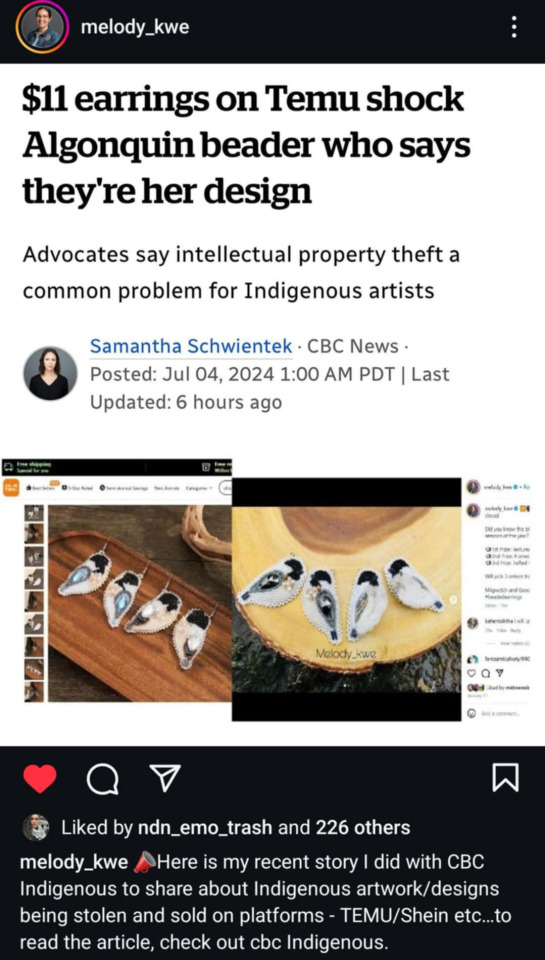
Don't support businesses that steal Indigenous artwork and then mass produce it for pennies. Support Indigenous artists and shops.
#your fave is anti native#temu#shein#cultural appropriation#art theft#cultural theft#this is not native#buy native#buy indigenous
1K notes
·
View notes
Text
this is about halloween costumes

I do think a lot of people who 'dress up' using native american head dresses r stupid. truly offensive. doing it is offensive. dont.
965 notes
·
View notes
Text

Article Link
"Minnetonka first started selling its “Thunderbird” moccasins in 1965. Now, for the first time, they’ve been redesigned by a Native American designer.
It’s one step in the company’s larger work to deal with its history of cultural appropriation. The Minneapolis-based company launched in the 1940s as a small business making souvenirs for roadside gift shops in the region—including Native American-inspired moccasins, though the business wasn’t started or run by Native Americans. The moccasins soon became its biggest seller.

[Photo: Minnetonka]
Adrienne Benjamin, an Anishanaabe artist and community activist who became the company’s “reconciliation advisor,” was initially reluctant when a tribal elder approached her about meeting with the company. Other activists had dismissed the idea that the company would do the work to truly transform. But Benjamin agreed to the meeting, and the conversation convinced her to move forward.
“I sensed a genuine commitment to positive change,” she says. “They had really done their homework as far as understanding and acknowledging the wrong and the appropriation. I think they knew for a long time that things needed to get better, and they just weren’t sure what a first step was.”

Pictured: Lucie Skjefte and son Animikii [Photo: Minnetonka]
In 2020, Minnetonka publicly apologized “for having benefited from selling Native-inspired designs without directly honoring Native culture or communities.” It also said that it was actively recruiting Native Americans to work at the company, reexamining its branding, looking for Native-owned businesses to partner with, continuing to support Native American nonprofits, and that it planned to collaborate with Native American artists and designers.
Benjamin partnered with the company on the first collaboration, a collection of hand-beaded hats, and then recruited the Minneapolis-based designer Lucie Skjefte, a citizen of the Red Lake Nation, who designed the beadwork for another moccasin style and a pair of slippers for the brand. Skjefte says that she felt comfortable working with the company knowing that it had already done work with Benjamin on reconciliation. And she wasn’t a stranger to the brand. “Our grandmothers and our mothers would always look for moccasins in a clutch kind of situation where they didn’t have a pair ready and available to make on their own—then they would buy Minnetonka mocs and walk into a traditional pow wow and wear them,” she says. Her mother, she says, who passed away in 2019, would have been “immensely proud” that Skjefte’s design work was part of the moccasins—and on the new version of the Thunderbird moccasin, one of the company’s top-selling styles.
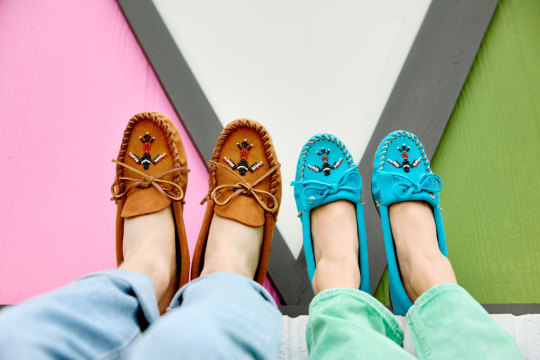
[Photo: Minnetonka]
“I started thinking about all of those stories, and what resonated with me visually,” Skjefte says. The redesign, she says, is much more detailed and authentic than the previous version. “Through the redesign and beading process, we are actively reclaiming and reconnecting our Animikii or Thunderbird motif with its Indigenous roots,” she says. Skjefte will earn royalties for the design, and Minnetonka will also separately donate a portion of the sale of each shoe to Mni Sota Fund, a nonprofit that helps Native Americans in Minnesota get training and capital for home ownership and entrepreneurship.
Some companies go a step farther—Manitobah Mukluks, based in Canada, has an Indigenous founder and more than half Indigenous staff. (While Minnetonka is actively recruiting more Native American workers, the company says that employees self-report race and it can’t share any data about its current number of Indigenous employees.) Beyond its own line of products, Manitobah also has an online Indigenous Market that features artists who earn 100% of the profit for their work.
White Bear Moccasins, a Native-owned-and-made brand in Montana, makes moccasins from bison hide. Each custom pair can take six to eight hours to make; the shoes cost hundreds of dollars, though they can also be repaired and last as long as a lifetime, says owner Shauna White Bear. In interviews, White Bear has said that she wants “to take our craft back,” from companies like Minnetonka. But she also told Fast Company that she doesn’t think that Minnetonka, as a family-owned business, should have to lose its livelihood now and stop making moccasins.
The situation is arguably different for other fashion brands that might use a Native American symbol—or rip off a Native American design completely—on a single product that could easily be taken off the market. Benjamin says that she has also worked with other companies that have discontinued products.
She sees five steps in the process of reconciliation. First, the person or company who did wrong has to acknowledge the wrong. Then they need to publicly apologize, begin to change behavior, start to rebuild trust, and then, eventually, the wronged party might take the step of forgiveness. Right now, she says, Minnetonka is in the third phase of behavior change. The brand plans to continue to collaborate with Native American designers.
The company can be an example to others on how to listen and build true relationships, Benjamin says. “I think that’s the only way that these relationships are going to get any better—people have to sit down and talk about it,” she says. “People have to be real. People have to apologize. They have to want to reconcile with people.”
The leadership at Minnetonka can also be allies in pushing other companies to do better. “My voice is important at the table as an Indigenous woman,” Benjamin says. “Lucie’s voice is important. But at tables where there’s a majority of people that aren’t Indigenous, sometimes those allies’ voices are more powerful in those spaces, because that means that they’ve signed on to what we’re saying. The power has signed on to moving forward and we agree with ‘Yes, this was wrong.’ That’s the stuff that’s going to change [things] right there.”"
-via FastCompany, February 7, 2024
#indigenous#indigenous artists#indigenous art#moccasins#thunderbird#native american#native american art#cultural appropriation#indigenous peoples#cultural representation#minnesota#minnetonka#minneapolis#red lake nation#ojibwe#anishinaabe#reconciliation#fashion#fashion news#good news#hope#indigenous designers#native artist#indigenous artist
2K notes
·
View notes
Text
The same people who co-opt the term, "Rest in Power", for White celebs when they die are the same people who won't use the term for Black people who are murdered by antiblack institutions and systems like Marcellus Williams.
467 notes
·
View notes
Text
people have got to stop calling AAVE "gen z slang". words like rizz and woke and chile becoming known as gen z slang and then becoming known as cringe teenager slang is both appropriative and demeaning
and to add insult to injury, most people appropriating AAVE can't even be bothered to learn the correct definitions and contexts of the terms and phrases that they're using!! like, you're gonna appropriate Black culture AND get it wrong???
not to mention that people only use aave when they're trying to be sassy or are angry- the two most common stereotypes associated with Black people. or using it to be funny, which just means that you see AAVE as something to laugh at
can we just collectively shut the fuck up and stop cherry picking bits of other people's cultures to claim as our own? please?
2K notes
·
View notes
Text
youtube
ONE SCENE FOR FORGIVENESS (aka The Twilight Saga Is Racist)
BUY ME A KO-FI: https://ko-fi.com/alinahdee
HELP MOVE THE QUILUETE TRIBE TO HIGHER GROUND: https://mthg.org/
#ali nahdee#twilight#anti native racism#your fave is anti native#stephenie meyer#midnight sun#emily young#cultural appropriation#native american#indigenous#ndn#quileute#Youtube
417 notes
·
View notes
Text
I actually hate when goyim name their kids with explicitly Jewish names.
I do find it weird when I meet a goyisch Eliana or Elijah. And both of those names are in the top 100 SSA baby names.
I hate how goyim name their kids Levi, Eli, or Asher but pronounce their name lee-VAI and ee-LAI and A-shur.
I’ve met people named Ad-nai (w/o the hyphen obviously) and Aliyah, and none of them have been Jewish. I’ve never met a Jew with either of those names.
I know names like Benjamin, Sarah, and Noah are long gone. They’re so embedded into goyisch Christian culture that we’ll probably never be able to call them solely Jewish names. But why is that fair?
I hate how goyim seem to think that our holy books and our stories and our language and our names are for everyone. That so much “American” deli food is Ashkenazi food. That our rituals are appropriated so Christians can feel “closer to Jesus”. That our existence is ignored because the fact that we are still here, living and breathing, is inconvenient to their appropriation.
We’re often seen as some historical group, some ancient civilization, rather than a people who is still living.
Over and over again, our traditions and heritage are stolen from us, our meticulously recorded history is denied, and we are killed en masse.
Is it selfish that I just want our culture to be ours?
#people love dead jews#jewish#jumblr#chana talks#judaism#israel#am yisrael chai#antisemitism#cultural appropriation
566 notes
·
View notes
Text
I've honestly never heard it put like this but that's brilliant.
584 notes
·
View notes
Text
Remember when Tory Burch copied the Romanian cojoc worn by Queen Marie and called it African and when Dior said that Bihor rhymes so well that they have to copy the traditional designs?
Well... brace yourselves for Louis Vuitton and


I always wear my ie to the beach
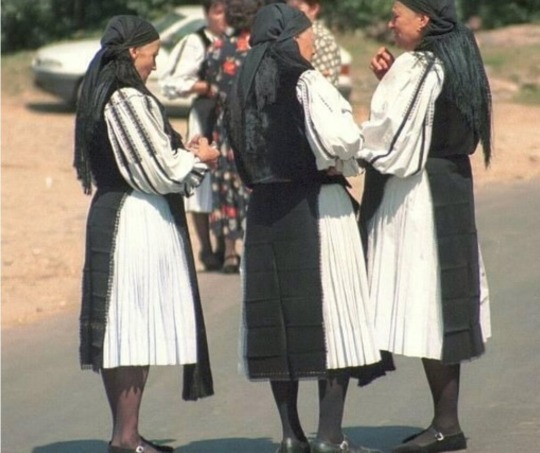

More here
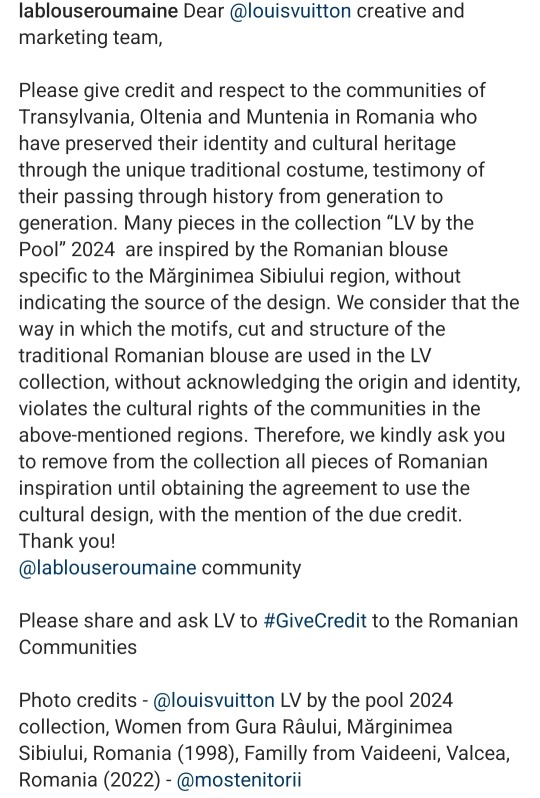
520 notes
·
View notes
Text

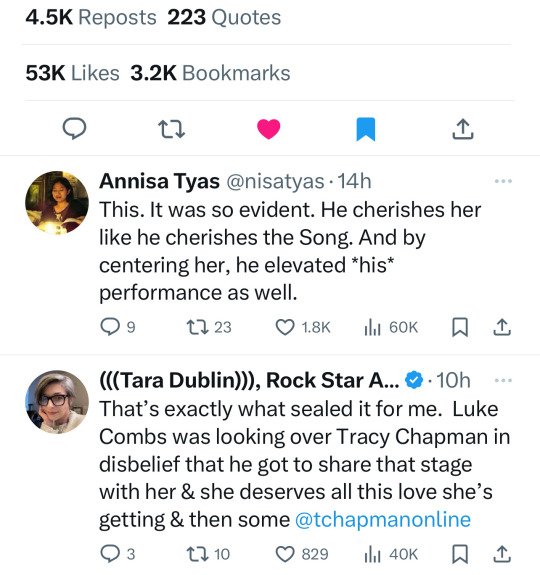
Tracy Chapman has herself said that she didn’t mind the remake because she is the sole writer of the song, and as such, she appreciates the royalties.
Luke’s version is getting a lot of airtime, but so is Tracy’s original version.

And Luke’s sincere and obvious appreciation of Chapman’s song is just icing on the cake:
When Luke Combs set out to cover Tracy Chapman's 1988 hit “Fast Car”, he did it out of complete admiration for the song
Although not every lyric makes sense being covered by a male vocalist, he decided not to deviate from the original lyrics out of respect for its original songwriter.
“You want to just be mega respectful of the original song,” Combs tells Kelleigh Bannen on Today's Country Radio. “That's why in that song ... it’s, ‘Work in the market as a checkout girl.’ I didn’t change that in my version — I really wanted to just do the original version of the song.”
Combs really wanted to bring the song as it was intended to be in presenting it to a new generation of fans who may have only been vaguely familiar with the original.
“It’s weird because you’re doing a cover of it, and you say, ‘I don’t want to make it my own, because I really just want to shine a light on the original version and bring that.’”
“Because I think there’s so many people that maybe know that song, or it would be familiar to them, but they really don’t know anything about it,” he explains. “They’ve never really listened to it.”
“When I recorded this, literally the engineer in there asked me who I wrote that song with,” Combs adds.
(continue reading)
#tracy chapman#luke combs#fast car#music#grammys#cultural appropriation#cultural appreciation#cultural appreciation vs. cultural appropriation
682 notes
·
View notes
Text
What is Cultural Appropriation?
Cultural appropriation is the wrongful use (e.g. ignorant consumption, theft, bastardization, oversimplification, or unauthorized commercial use) of cultural properties from a culture outside one’s own. If you use cultural customs or iconography without the understanding or regard to how it is meant to be used and by whom, you are appropriating. Similarly, in creative writing, you are appropriating if you divorce elements of a culture from their context and meaning, and bring them into your worldbuilding solely for their aesthetic value (“because it’s cool”).
This is different from “cultural appreciation,” which also involves using or adopting a cultural property, but done so in an appropriate context and often with the guidance or invitation of those from that culture.
Why is appropriation harmful? First, it contributes to the misrepresentation of these cultures in media, even if your work is understood to be fictional or speculative. Real life marginalized groups already have a hard time finding authentic representation. Second, it contributes to the history of colonial appropriation and theft. Stolen art and artifacts, many of which still unattributed or undated, remain in museums and private collections today. All because of people who felt entitled to the aesthetics of their colonial subjects while throwing out their cultural significance.
To avoid appropriation, do your research and engage in dialogue with people from that culture. Read their stories and talk with them. Ask them to critique your work and follow their feedback. Show care and respect.
Further Reading:
See our #cultural appropriation tag.
---
This Q&A is an excerpt from our General FAQ for Newcomers, which can be found in our new Masterpost of rules and FAQs. If you're looking for more resources on POC representation, start there!
-Writing With Color
#writing with color#writeblr#representation#poc representation#cultural appropriation#appropriation#writing advice#writing tips#writers on tumblr#faq
774 notes
·
View notes
Text
"Celtic shamanism" literally does not exist. The Celts never practiced shamanism. Whatever spiritualism that is Celtic in origin, it is not shamanism. White people actually learn your own histories and stop stealing shit from people of color challenge 2024.
#witches of color#cultural appropriation#closed practices#witchblr#paganblr#shamanism#misinformation#racism
424 notes
·
View notes
Text
So... I saw this post that screenshot the discourse between two Black women on Twitter over the usage of "Rest in Power" for Aaron Bushnell's self-immolation is appopriate. As non-Black leftists, I don't think we have a right to wade into the discourse among Black leftists in regards to this. However, I am disappointed and unsettled by some of the notes left on the post by non-Black users:


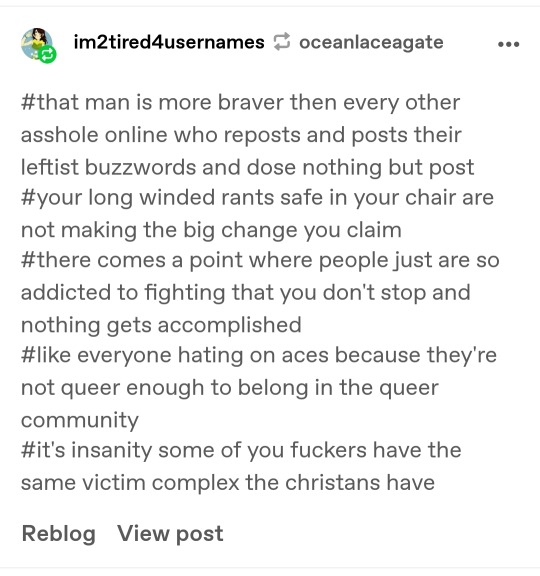
Black culture, AAVE in this case, has already has been appropriated for a long time, and the term, "Rest in Power" has been co-opted to hell and back by non-Black people. Black people on Twitter have said that they were being harassed for their criticism over using "Rest in Power" for Aaron Bushnell:


It is important for us as supporters of Palestinian liberation to acknowledge and honor Aaron Bushnell, I also believe that for non-Black allies of Palestinian liberation, we can do that in a way that do not co-opt the language of Black radical movements and definitely does not dismiss the concerns and critiques of our fellow Black allies. Please remember that we always have to be aware of perpetuating antiblackness within the Free Palestine movement. Are we being inclusive in our activism or are we just being performative?
Here are some tweets by Black Twitter users on this:

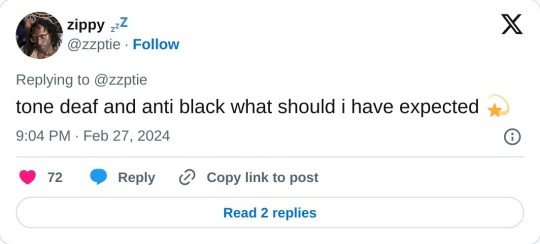



1K notes
·
View notes
Text

youtube
Until Dawn is getting remastered for the PS5 so I definitely needed to share this again.
In this episode I talk about the video game's appropriation of Native American cultures, imagery and spirituality. I'm not saying don't buy and enjoy the game.
I am saying that when you know better, do better, and then demand better.
#until dawn#ali nahdee#native american#indigenous#first nations#cultural appropriation#anti-native racism#Youtube
419 notes
·
View notes
Text
I've seen goyim push back against us Jews rightfully telling them they can't learn Kabbalah by saying "b-but learning isn't the same as practicing!!"
Congratulations, you just showed your culturally Christian ass.
In Christianity, practice is only about belief and acts of faith, like praying and attending Church. While Bible study is important, it's not integral to being a Christian. Most Christians don't have a library full of medieval Christian literature.
In Judaism, learning material is *part* of practice. If you walk into the home of a practicing Jew, chances are they will have bookshelves of books, even if they're not Rabbis or educators. Learning Torah is part of practicing Judaism, just as learning Kabbalah is part of practicing Kabbalah. We collect books because books are part of our practice.
In Judaism, learning is a holy act. Before we start learning, we say a special prayer thanking G-d for gifting us His words. In some communities, learning Torah is forbidden on days of mourning like the Shiva period and Christmas Eve, because the holiness of Torah shouldn't interact with the sadness of the time. We also have times when learning Torah is especially meritorious, such as the night of certain holidays and before one's wedding. When we complete our study of a book of Jewish texts, we have a special celebration to commemorate it.
We have a holiday called Simchat Torah where we celebrate completing the reading of the entire Torah scroll all year, and celebrate re-rolling the scroll to the beginning, where we begin reading it from the start all over again. A Torah scroll, on that note, is given immense status. Many times Jews will risk their lives to save Torah scrolls- for example, after the recent earthquakes in Turkey and Syria, Jews risked entering an unstable historic synagogue to rescue the Torah scrolls inside.
And all Jewish texts are treated with care- if a book or text is damaged beyond repair, it can't be thrown out, it must be buried like a human body. On first glance, a mass-printed Tanakh and mass-printed Christian Bible may look similar. Except if a Tanakh is dropped accidentally, it is kissed, and if it's damaged beyond repair, it is buried with full respect. This is because learning is *integral* to Judaism. Studying our texts is integral to our practice. It's not enough to attend synagogue, you must make yourself familiar with the texts.
Learning Kabbalah is practicing Kabbalah, which is why we say that no, goyim shouldn't learn about Kabbalah. Is it not enough that we say it's wrong for you to listen to us? I think part of the reason goyim are so entitled to our texts is because deep down, they believe that we're hiding something in them, and they don't trust us. We're not hiding something, we just have our privacy and our boundaries and you are not entitled to everything.
#jumblr#antisemitism#cultural appropriation#cultural christianity#Christianity#judaism#pagan antisemitism#occult antisemitism#kabbalah appropriation#kabbalah
2K notes
·
View notes